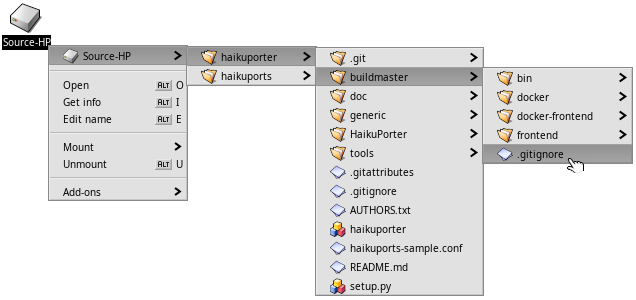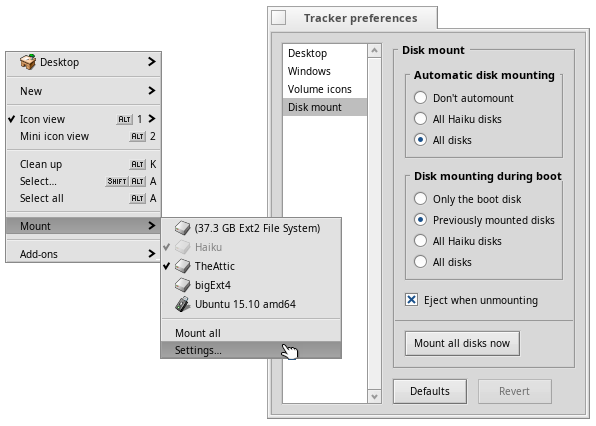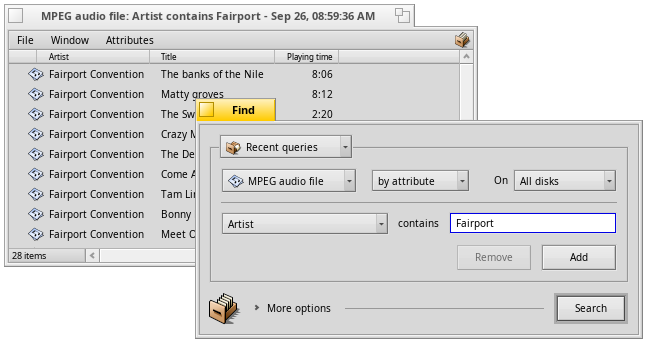| Tabele |
|
[1] Welcome [2] The Deskbar [3] The window widgets [4] The shortcut key [5] The Twitcher [6] The Team monitor [7] Window management: Move & Resize [8] Window management: Stack [9] Window management: Tile [10] Workspaces [11] Replicants [12] Single window navigation [13] Drill-down navigation [14] Mounting volumes [15] Filesystem layout [16] Finding files with queries [17] Wireless connection [18] Getting more and updating software [19] The end |
Benvignûts te vuide rapide di Haiku
Ancje se Haiku al condivît tantis ideis cun altris sistemis operatîfs, al à metodichis unichis in cualchi contest che a meretin di jessi sotlineadis. In juste pocjis diapositivis, tu impararâs alc su lis plui impuartantis funzionalitâts di Haiku e lis peculiaritâts che ti judaran a doprâ il sisteme cun rapiditât.
Par ogni argoment tu puedis cjatâ un ricuadri cun colegaments a "aprofondiments" che a pontin a risorsis adizionâls, come argoments corelâts inte Vuide utent.
Il Deskbar
| Aprofondiments |
| Deskbar |
Te configurazion predefinide, tal angul in alt a diestre dal scritori, si à il Deskbar, che al è il centri di interazion cun Haiku. Di lì, par esempli, tu puedis fâ partî aplicazions, applet e preferencis e passâ di une aplicazion a chês altris.

I elements dal barcon
| Aprofondiments |
| Interface grafiche di Haiku |
Achì si à un tipic barcon di Haiku cui siei elements usuâi:

Il tast di scurte
| Aprofondiments |
| Scurtis e cumbinazions di tascj |
Lis preferencis di Mape tastiere ti permeti di passâ dal tast standard di Haiku ALT a CTRL (modalitât Windows/Linux). Chest passaç al è globâl, duncje par esempli sierâ un program inte shell al vignarà fat cun ALT C al puest dal solit CTRL C.
Cheste incoerence e je une des resons pe scurte predefinide ALT in Haiku.

Il Twitcher
| Aprofondiments |
| Il Twitcher |
Tignint fracât CTRL TAB al ven fûr il Twitcher dulà che tu puedis passâ di une aplicazion in chês altris.
Fracant veloç il tast TAB intant che si ten fracât CTRL al passe ae ultime aplicazion doprade in precedence.

Il Monitor dai Team
| Aprofondiments |
| Monitor dai Team |
Se cualchi aplicazion e colasse di brut e metìn che no sparìs de liste des aplicazions in esecuzion dal Deskbar, frache CTRL ALT CANC par invocâ il Monitor dai Team. Chi tu puedis selezionâ une vôs e copâ une aplicazion che no si compuarte come che si dîs.

Une maniere linde par fâ fûr daurman une aplicazion che e je restade peade tal Deskbar e je la Smuarse de Muart Vulcaniche.
Ten fracât MAIUSC CTRL ALT e fâs clic su la vôs incriminade tal Deskbar. E vie lui!
Gjestion dal barcon: spostâ e ridimensionâ
| Aprofondiments |
| Un mût veloç par spostâ e ridimensionâ i barcons |
Haiku offers a neat way to quickly move or resize windows:
Holding down CTRL ALT will highlight the window borders nearest to the mouse pointer.
Click and dragging with the right mouse button will resize the window along the highlighted border(s).
Click and drag with the left mouse button to move it around.

Gjestion dai barcons: Intassâ
| Aprofondiments |
| Intassâ e intasselâ |
"Stacking" is putting windows on top of each other, automatically moving the yellow tabs into position.
While holding the OPT key (normally that's WIN on the keyboard), tabs change color when they overlap; drop the window to establish the stacking.
You un-stack by holding OPT and dragging a window out of its group by the yellow tab.

Gjestion dai barcons: intasselâ
| Aprofondiments |
| Intassâ e intasselâ |
"Tiling" means gluing windows horizontally or vertically together.
While holding OPT, the borders that'll fuse together when you drop the window change color when brought near each other.
You un-tile by holding OPT and dragging a window out of its group by the yellow tab.

Spazis di lavôr
| Aprofondiments |
|
Spazis di lavôr Schermi |
Workspaces are virtual desktops, complete with their own resolution, color depth and background.
Up to 32 of these workspaces can be set from the Screen preferences.
The Workspaces desktop applet can be used to change workspaces or to drag a window from one to another.
The quick keyboard shortcut to change workspaces is CTRL ALT ← / → / ↑ / ↓.
If you add SHIFT to that, the active window is taken with you to that workspace.

Replicants
| Aprofondiments |
| Replicants |
Replicants are small self-contained parts of applications that can be integrated into the Desktop (and other programs).
Provided Deskbar's option to is activated, replicants are indicated by a small handle.
You can drag & drop them by the handle onto the Desktop, where they are fully functional without their parent app running.

You can move a replicant by its handle and remove it with a right-click on it and choosing .
Navigazion a singul barcon
| Aprofondiments |
| Tracker |
Double-clicking your way down folder after folder, you'll quickly end up with many open Tracker windows.
Holding the OPT key (normally WIN on the keyboard) prevents this as it automatically closes the parent folder.
Alternatively, you can activate from the Tracker preferences.
will add back/forward buttons.

Navigazion sgarfant te jerarchie
| Aprofondiments |
| Navigazion cun Tracker |
A nice alternative to opening a deep hierarchy of folders is called "drill-down navigation". Right-clicking a folder or anywhere in a Tracker window (or the Desktop) will open a context menu. Beside various expected commands, there's a menu of the current folder at the top that contains all its subfolders.
Drill your way down until you find the folder or file to open.

Mounting volumes
| Aprofondiments |
| Mounting volumes |
In order to access a harddisk, CD, USB stick etc., you first have to mount the volume. Once mounted, its icon appears on the Desktop.
This is done with a right-click on the Desktop or an already mounted volume (like the boot disk) and choosing the volume from the submenu. You find the same menu in the Deskbar. ISO images can be mounted with a double-click.

Disposizion dal Filesystem
| Aprofondiments |
|
Disposizion dal filesystem Aplicazions Struture des cartelis |
While Haiku is currently not multi-user, there are already two branches in the filesystem tree:
 /boot/system/ | The system hierarchy contains system files and settings for all users. The package management makes most folders under /system effectively read-only. Packages contain all their files in a fixed folder hierarchy. Upon installation, a package gets "mounted" and all its files just appear to be in that hierarchy in the /system folder. The folders there (like add-ons, apps, bin etc.) are just a virtual amalgamation of all the installed packages and are therefore read-only. Exceptions are cache, non-packaged, settings, and var.
| |
 /boot/home/ | The home hierarchy is your personal folder where you keep your data and settings. The folder /boot/home/config (or shortened ~/config) mirrors the /system folder described above and is likewise virtually read-only with the same exceptions of cache, non-packaged, settings, and var.
|
The writable non-packaged folders mirror the hierarchy of the /system or ~/config/ hierarchy (add-ons, apps, bin…).
Software that doesn't come in form of a HPKG package can be installed here.
Cjatâ i files cu lis interogazions
| Aprofondiments |
|
Interogazions Gjenars di file, atribûts, tabele e interogazions |
Files on Haiku formatted (BFS) volumes are quickly searched with from the Deskbar. Instead of file and folder names, you can also look through filetype specific attributes, e.g. for an artist in your MP3 collection.

Conession cence fîi
| Aprofondiments |
|
Rêts cence fîi Stât de Rêt Preferencis de Rêt |
You can connect to your WLAN router either by right-clicking the NetworkStatus icon in Deskbar's tray,
or by selecting your network from the Network preferences.
When the connection is established, you'll be asked for the network's encryption and password.

Otignî plui software e inzornâlu
| Aprofondiments |
|
HaikuDepot SoftwareUpdater Dipuesits |
HaikuDepot from the Deskbar's applications menu is where to search, install and uninstall software packages.
SoftwareUpdater should be started from time to time to update installed software as well as Haiku itself.

Fin
Cheste e je la fin de vuide. O sperìn che ti vedi judât a cjatâti subite a cjase tal to gnûf sisteme operatîf!
Par vê informazions plui detaiadis, bute un voli ae Pagjine di benvignût e ae Vuide utent.
Tu puedis ancje unîti al nestri Webforum e al canâl IRC principâl #haiku par otignî jutori o discuti lis tôs ideis.
Il sît web di Haiku al à informazions su cemût partecipâ e puartâ indenant Haiku. Tu puedis ancje fâ donazions finanziariis.
